sensor TOYOTA YARIS 2020 Owners Manual (in English)
[x] Cancel search | Manufacturer: TOYOTA, Model Year: 2020, Model line: YARIS, Model: TOYOTA YARIS 2020Pages: 572, PDF Size: 7.94 MB
Page 4 of 572

TABLE OF CONTENTS4
YARIS_YARIS HATCHBACK_OM_OM99V59z_(U)
3-6. ABS/TCS/DSCAntilock Brake System (ABS) .............................. 215
Traction Control System (TCS) .............................. 216
Dynamic Stability Control (DSC) .............................. 218
3-7. Fuel Economy Monitor Fuel Economy Monitor ...... 221
3-8. Drive Selection Drive Selection (Automatic Transaxle) ..... 224
3-9. Power Steering Power Steering.................. 226
3-10. Active Safety System Active Safety System ........ 227
Low Speed Pre-Collision System ............................ 228
Laser Sensor ..................... 234
3-11. Cruise Control Cruise Control ................... 236
3-12. Tire Pressure Monitoring System
Tire Pressure Monitoring System ............................ 241
3-13. Rear View Monitor Rear View Monitor............. 245 4-1. Climate Control System
Operating Tips ................... 256
Vent Operation .................. 257
Manual Type ...................... 259
Fully Automatic Type ......... 266
4-2. Audio System Antenna ............................. 271
Operating Tips for Audio System ............................ 273
Audio Set ........................... 283
Audio Control Switch Operation......................... 304
AUX/USB mode ................. 307
4-3. Bluetooth
®
Bluetooth®......................... 327
Bluetooth® Hands-Free ..... 339
Bluetooth® Audio ............... 353
Troubleshooting ................. 366
4-4. Interior Equipment Sunvisors ........................... 374
Interior Lights ..................... 375
Accessory Socket .............. 378
Cup Holder ........................ 379
Bottle Holder ...................... 380
Storage Compartments ..... 381
4Interior Features
Page 39 of 572
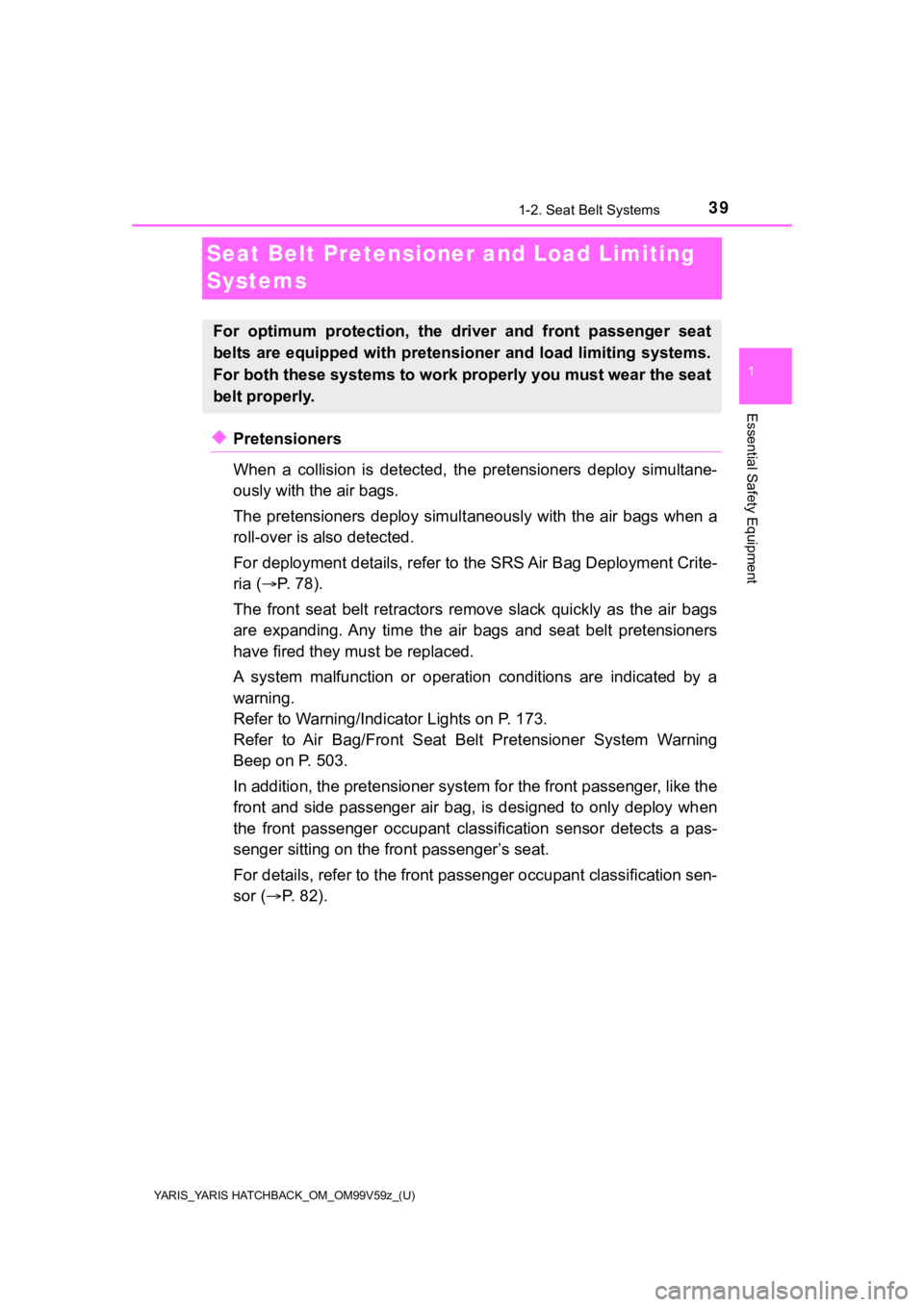
39
YARIS_YARIS HATCHBACK_OM_OM99V59z_(U)
1-2. Seat Belt Systems
1
Essential Safety Equipment
Seat Belt Pretensioner and Load Limiting
Systems
◆Pretensioners
When a collision is detected, the pretensioners deploy simultan e-
ously with the air bags.
The pretensioners deploy simult aneously with the air bags when a
roll-over is also detected.
For deployment details, refer to the SRS Air Bag Deployment Cri te-
ria ( P. 78).
The front seat belt retractors remove slack quickly as the air bags
are expanding. Any time the air bags and seat belt pretensioners
have fired they must be replaced.
A system malfunction or operation conditions are indicated by a
warning.
Refer to Warning/Indi cator Lights on P. 173.
Refer to Air Bag/Front Seat Belt Pretensioner System Warning
Beep on P. 503.
In addition, the pretensioner system for the front passenger, l ike the
front and side passenger air bag, is designed to only deploy wh en
the front passenger occupant class ification sensor detects a pas-
senger sitting on the front passenger’s seat.
For details, refer to the front passenger occupant classificati on sen-
sor ( P. 8 2 ) .
For optimum protection, the d river and front passenger seat
belts are equipped with pretensi oner and load limiting systems.
For both these systems to work properly you must wear the seat
belt properly.
Page 44 of 572
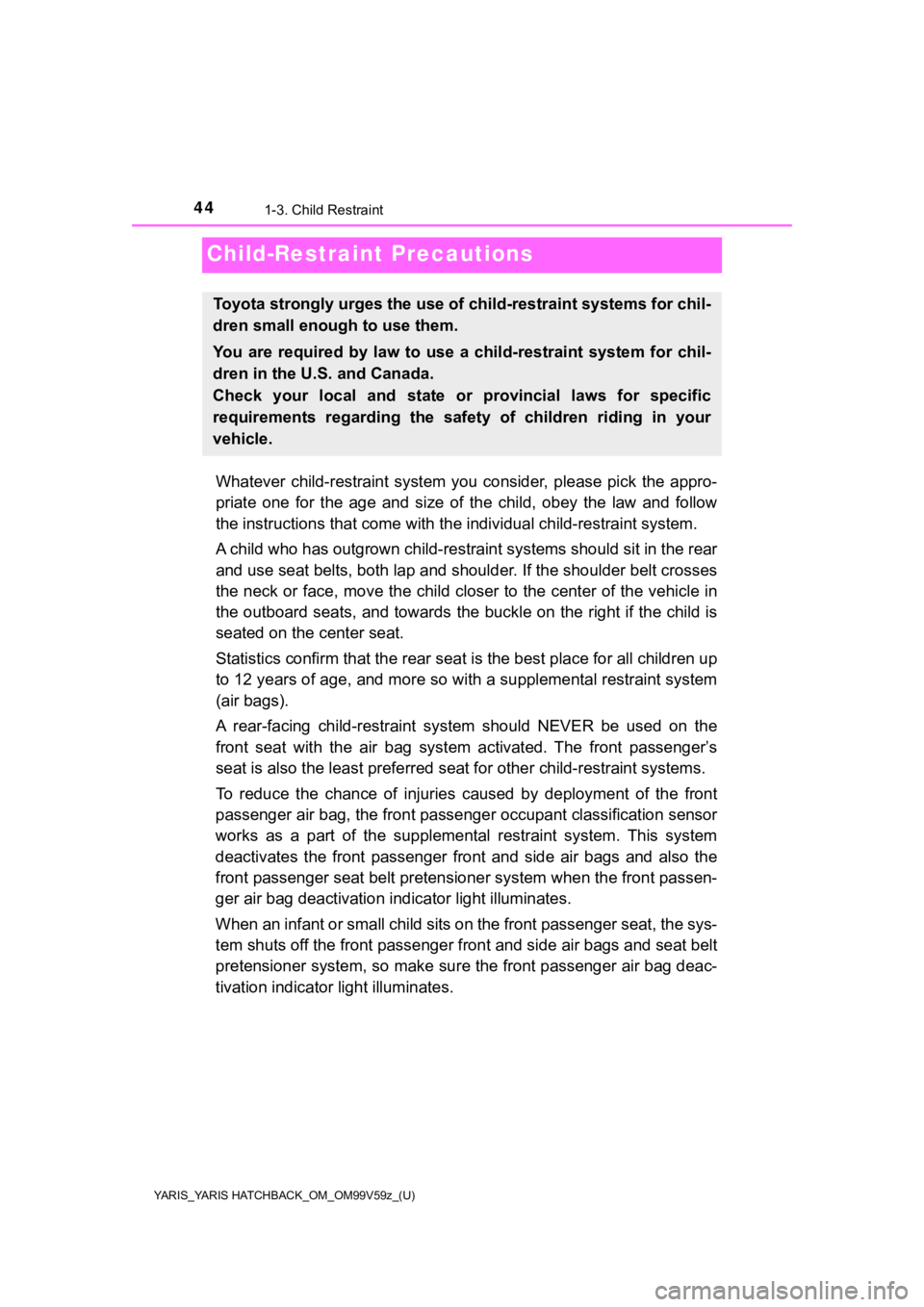
44
YARIS_YARIS HATCHBACK_OM_OM99V59z_(U)
1-3. Child Restraint
Child-Restraint Precautions
Whatever child-restraint system you consider, please pick the appro-
priate one for the age and size of the child, obey the law and follow
the instructions that come wit h the individual child-restraint system.
A child who has outgrown child-re straint systems should sit in the rear
and use seat belts, both lap and shoulder. If the shoulder belt crosses
the neck or face, move the child closer to the center of the ve hicle in
the outboard seats, and towards the buckle on the right if the child is
seated on the center seat.
Statistics confirm that the rear seat is the best place for all children up
to 12 years of age, and more so w ith a supplemental restraint system
(air bags).
A rear-facing child-restraint system should NEVER be used on th e
front seat with the air bag syst em activated. The front passeng er’s
seat is also the leas t preferred seat for other child-restraint systems.
To reduce the chance of injuries caused by deployment of the front
passenger air bag, the front passenger occupant classification sensor
works as a part of the supplemen tal restraint system. This system
deactivates the front passenger front and side air bags and als o the
front passenger seat belt pretens ioner system when the front passen-
ger air bag deactivation ind icator light illuminates.
When an infant or small child sits on the front passenger seat, the sys-
tem shuts off the front passeng er front and side air bags and seat belt
pretensioner system, so make sur e the front passenger air bag deac-
tivation indicator light illuminates.
Toyota strongly urges the use of child-restraint systems for chil-
dren small enough to use them.
You are required by law to use a child-restraint system for chil-
dren in the U. S. and Canada.
Check your local and state or provincial laws for specific
requirements regarding the safety of children riding in your
vehicle.
Page 45 of 572

YARIS_YARIS HATCHBACK_OM_OM99V59z_(U)
451-3. Child Restraint
1
Essential Safety Equipment
Even if the front passenger air bag is shut off, Toyota strongly recom-
mends that children be properly restrained and child-restraint systems
of all kinds are properly secured on the rear seats which are t he best
place for children.
For more details, refer to “Fron t passenger occupant classification
sensor” ( P. 82).
Your Toyota is equipped with LATCH lower anchors for attachment of spe-
cially designed LATCH child-restraint systems on the rear seats. When using
these anchors to secure a child-restraint system, refer to “Usi ng LATCH
Lower Anchor” ( P. 61).
WARNING
■Use the correct size child-restraint system
For effective protection in vehicle accidents and sudden stops, a child must
be properly restrained using a seat belt or child-restraint sys tem depending
on age and size. If not, the child could be seriously injured o r even killed in
an accident.
■ Follow the manufacturer’s instructions and always keep the chil d-
restraint system buckled down
An unsecured child-restraint system is dangerous. In a sudden s top or a
collision it could move causing serious injury or death to the child or other
occupants. Make sure any child-restraint system is properly sec ured in
place according to the child-restraint system manufacturer’s in structions.
When not in use, remove it from the vehicle or fasten it with a seat belt, or
attach it to BOTH LATCH lower anchors for LATCH child-restraint systems
and the corresponding tether anchor.
■ Always secure a child in a proper child-restraint system
Holding a child in your arms while the vehicle is moving is ext remely dan-
gerous. No matter how strong the person may be, he or she canno t hold
onto a child in a sudden stop or collision and it could result in serious injury
or death to the child or other occupants. Even in a moderate accident, the
child may be exposed to air bag forces that could result in ser ious injury or
death to the child, or the child may be slammed into an adult, causing injury
to both child and adult.
Page 47 of 572
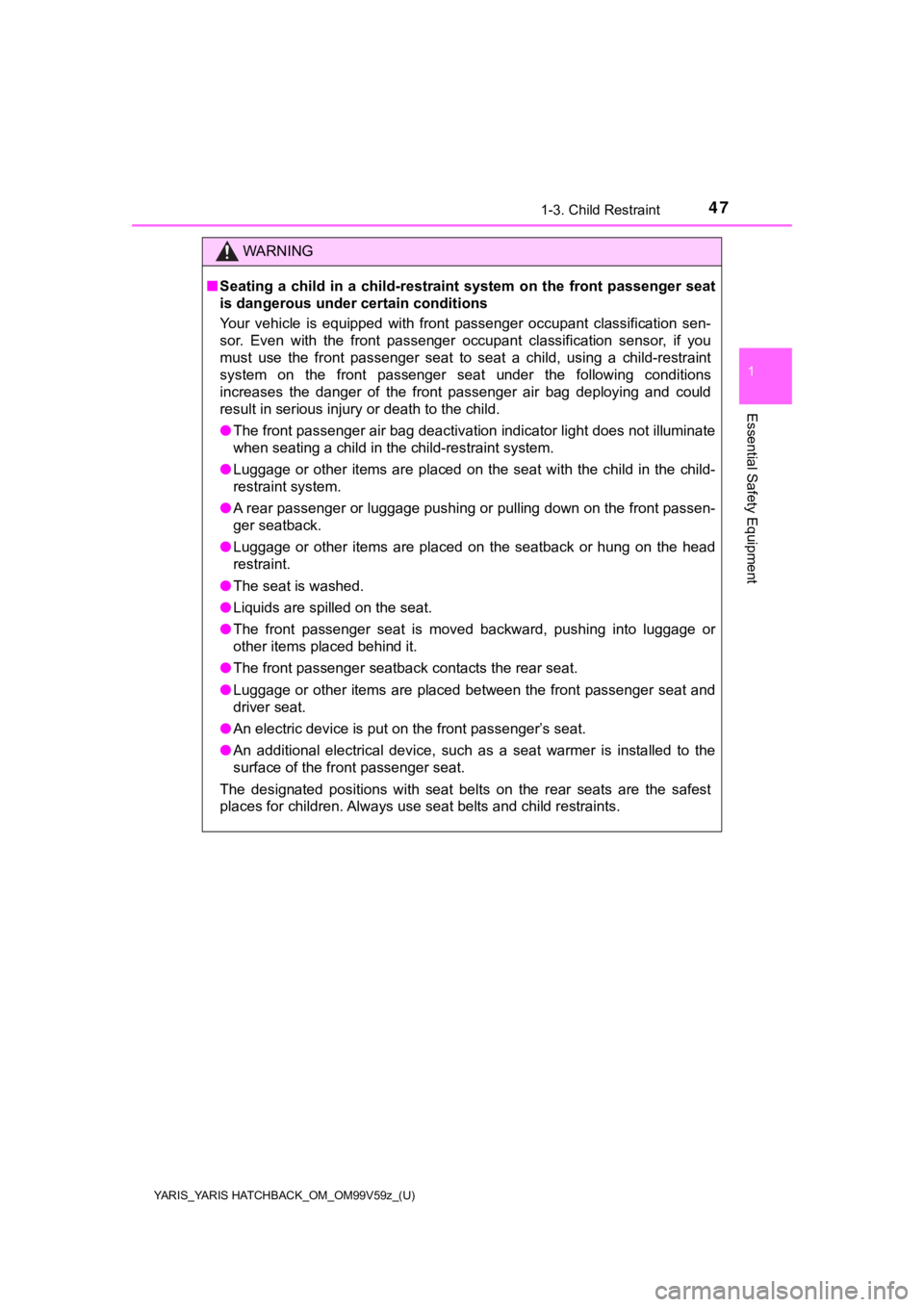
YARIS_YARIS HATCHBACK_OM_OM99V59z_(U)
471-3. Child Restraint
1
Essential Safety Equipment
WARNING
■Seating a child in a child-restraint system on the front passen ger seat
is dangerous under certain conditions
Your vehicle is equipped with front passenger occupant classifi cation sen-
sor. Even with the front passenger occupant classification sensor, if you
must use the front passenger seat to seat a child, using a chil d-restraint
system on the front passenger seat under the following conditio ns
increases the danger of the front passenger air bag deploying a nd could
result in serious injury or death to the child.
● The front passenger air bag deactivation indicator light does not illuminate
when seating a child in the child-restraint system.
● Luggage or other items are placed on the seat with the child in the child-
restraint system.
● A rear passenger or luggage pushing or pulling down on the front passen-
ger seatback.
● Luggage or other items are placed on the seatback or hung on the head
restraint.
● The seat is washed.
● Liquids are spilled on the seat.
● The front passenger seat is moved backward, pushing into luggag e or
other items placed behind it.
● The front passenger seatback contacts the rear seat.
● Luggage or other items are placed between the front passenger s eat and
driver seat.
● An electric device is put on the front passenger’s seat.
● An additional electrical device, such as a seat warmer is installed to the
surface of the front passenger seat.
The designated positions with seat belts on the rear seats are the safest
places for children. Always use seat belts and child restraints .
Page 51 of 572
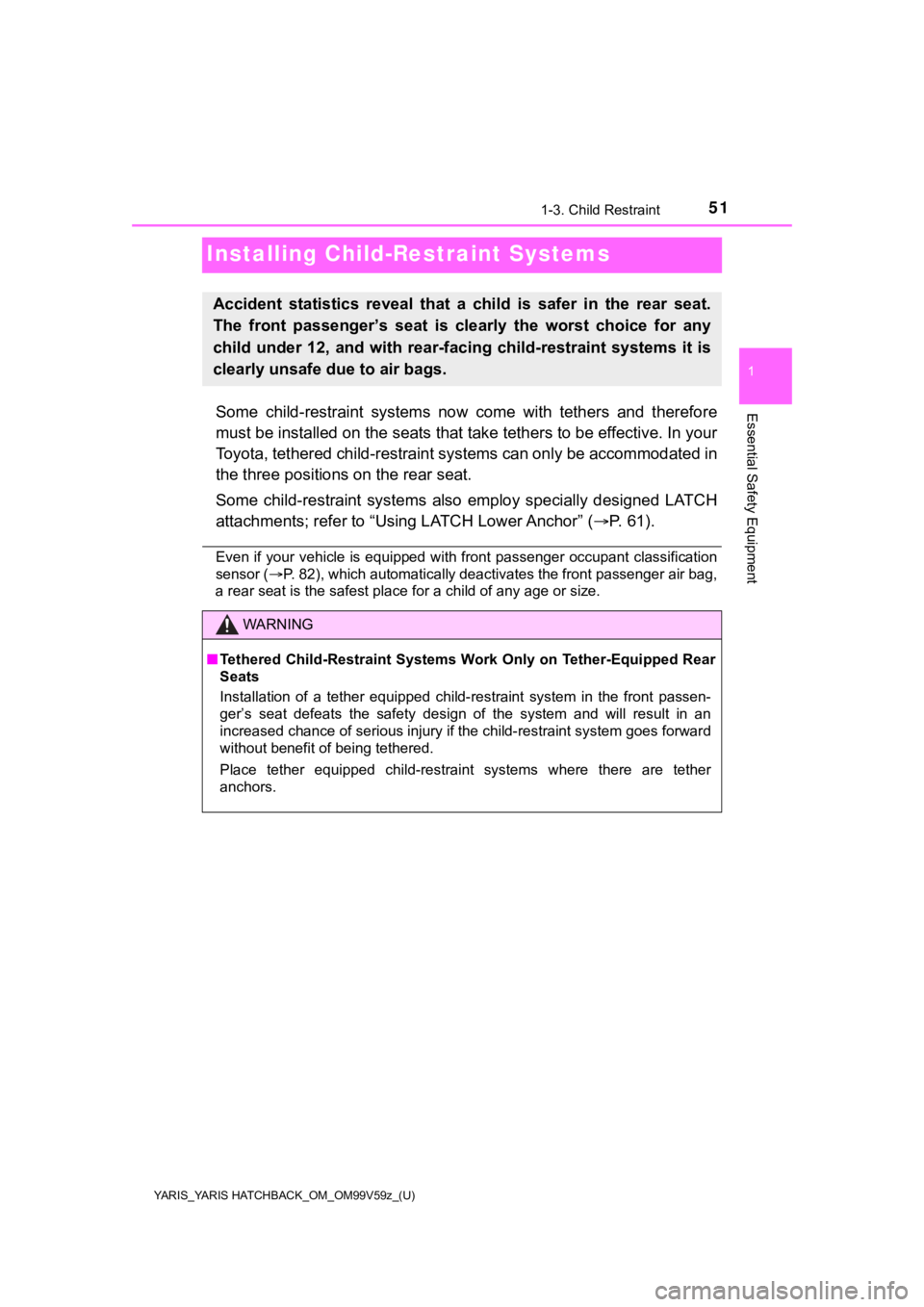
51
YARIS_YARIS HATCHBACK_OM_OM99V59z_(U)
1-3. Child Restraint
1
Essential Safety Equipment
Installing Child-Restraint Systems
Some child-restraint systems now come with tethers and therefore
must be installed on the seats that take tethers to be effectiv e. In your
Toyota, tethered child-restraint systems can only be accommodat ed in
the three positions on the rear seat.
Some child-restraint systems also employ specially designed LATCH
attachments; refer to “Usin g LATCH Lower Anchor” (P. 6 1 ) .
Even if your vehicle is equipped with front passenger occupant classification
sensor ( P. 82), which automatically deactivates the front passenger air bag,
a rear seat is the safest place for a child of any age or size.
Accident statistics reveal that a child is safer in the rear se at.
The front passenger’s seat is clearly the worst choice for any
child under 12, and with rear-f acing child-restraint systems it is
clearly unsafe due to air bags.
WARNING
■ Tethered Child-Restraint Systems Work Only on Tether-Equipped Rear
Seats
Installation of a tether equipped child-restraint system in the front passen-
ger’s seat defeats the safety design of the system and will res ult in an
increased chance of serious injury if the child-restraint syste m goes forward
without benefit of being tethered.
Place tether equipped child-restraint systems where there are tether
anchors.
Page 57 of 572
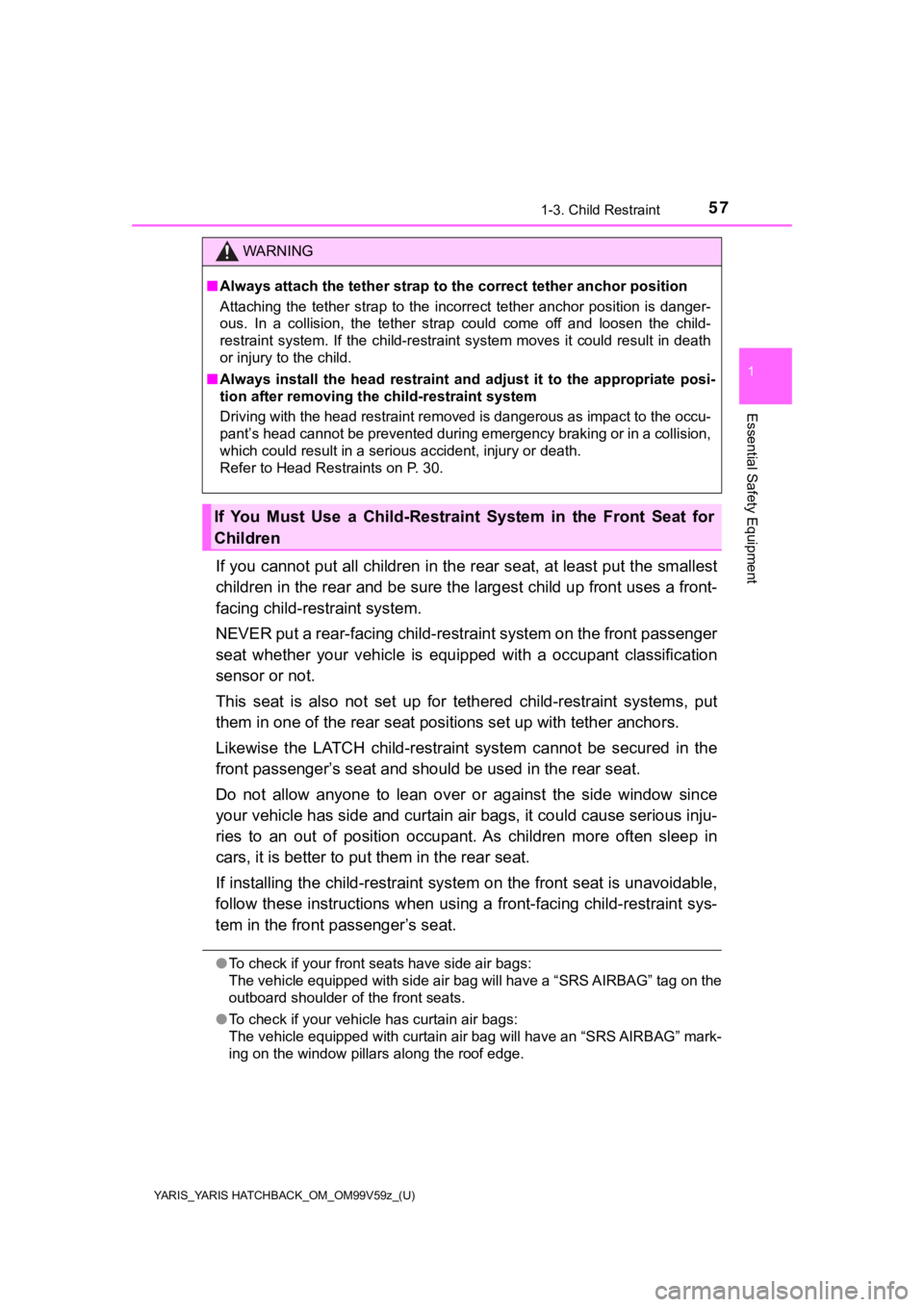
YARIS_YARIS HATCHBACK_OM_OM99V59z_(U)
571-3. Child Restraint
1
Essential Safety Equipment
If you cannot put all children in the rear seat, at least put the smallest
children in the rear and be sure the largest child up front use s a front-
facing child-restraint system.
NEVER put a rear-facing child-restraint system on the front pas senger
seat whether your vehicle is equ ipped with a occupant classification
sensor or not.
This seat is also not set up for tethered child-restraint syste ms, put
them in one of the rear seat posit ions set up with tether anchors.
Likewise the LATCH child-restraint system cannot be secured in the
front passenger’s se at and should be used in the rear seat.
Do not allow anyone to lean over or against the side window sin ce
your vehicle has side and curt ain air bags, it could cause serious inju-
ries to an out of position occup ant. As children more often sleep in
cars, it is better to pu t them in the rear seat.
If installing the child-restraint system on the front seat is u navoidable,
follow these instructions when using a front-facing child-restraint sys-
tem in the front passenger’s seat.
●To check if your front seats have side air bags:
The vehicle equipped with side air bag will have a “SRS AIRBAG” tag on the
outboard shoulder of the front seats.
● To check if your vehicle has curtain air bags:
The vehicle equipped with curtain air bag will have an “SRS AIR BAG” mark-
ing on the window pillars along the roof edge.
WARNING
■ Always attach the tether strap to the correct tether anchor pos ition
Attaching the tether strap to the incorrect tether anchor position is danger-
ous. In a collision, the tether strap could come off and loosen the child-
restraint system. If the child-restraint system moves it could result in death
or injury to the child.
■ Always install the head restraint and adjust it to the appropriate posi-
tion after removing the child-restraint system
Driving with the head restraint removed is dangerous as impact to the occu-
pant’s head cannot be prevented during emergency braking or in a collision,
which could result in a serious accident, injury or death.
Refer to Head Restraints on P. 30.
If You Must Use a Child-Restrai nt System in the Front Seat for
Children
Page 66 of 572

66
YARIS_YARIS HATCHBACK_OM_OM99V59z_(U)
1-4. SRS Air Bags
Supplemental Restraint System (SRS) Pre-
cautions
The front and side supplemental r estraint systems (SRS) include dif-
ferent types of air bags. Please verify the different types of air bags
which are equipped on your vehicl e by locating the “SRS AIRBAG”
location indicators. These indicators are visible in the area w here the
air bags are installed.
The air bags are installed in the following locations:
• The steering wheel hub (driver air bag)
• The front passenger dashboard (front passenger air bag)
• The outboard sides of the fron t seatbacks (side air bags)
• The front and rear window pilla rs, and the roof edge along both
sides (curtain air bags)
Vehicles with the Front Passenger Occupant Classification System
have a sensor which detects an impending roll-over accident.
The air bag supplemental restraint systems are designed to provide
supplemental protection in certa in situations so seat belts are always
important in the following ways:
Without seat belt usage, the ai r bags cannot provide adequate p rotec-
tion during an accident. Seat belt usag e is necessary to:
• Keep the occupant from being thr own into an inflating air bag.
• Reduce the possibility of injur ies during an accident that is not
designed for air bag inflati on, such as rear impact.
• Reduce the possibility of injuries in frontal, near frontal or side colli-
sions or roll-over accidents that are not severe enough to acti vate
the air bags.
• Reduce the possibility of being thrown from your vehicle.
• Reduce the possibility of injurie s to lower body and legs duri ng an
accident because the ai r bags provide no protection to these pa rts
of the body.
• Hold the driver in a position wh ich allows better control of the vehi-
cle.
Page 70 of 572

70
YARIS_YARIS HATCHBACK_OM_OM99V59z_(U)
1-4. SRS Air Bags
WARNING
■Do not touch the components of t he supplemental restraint system
after the air bags have inflated
Touching the components of the supplemental restraint system after the air
bags have inflated is dangerous. Immediately after inflation, t hey are very
hot. You could get burned.
■ Never install any front-end equipment to your vehicle
Installation of front-end equipment, such as frontal protection bar (kangaroo
bar, bull bar, push bar, or other similar devices), snowplow, o r winches, is
dangerous. The air bag crash sensor system could be affected. T his could
cause air bags to inflate unexpectedly, or it could prevent the air bags from
inflating during an accident. Front occupants could be seriously injured.
■ Do not modify the suspension
Modifying the vehicle suspension is dangerous. If the vehicle’s height or the
suspension is modified, the vehicle will be unable to accurately detect a col-
lision or roll-over accident resulting in incorrect or unexpect ed air bag
deployment and the possibility of serious injuries.
■ To prevent false detection by t he air bag sensor system, heed t he fol-
lowing
● Do not use tires or wheels other than those specified for your To y o t a :
Use of any tire or wheel other than those specified for your To yota (P. 553)
is dangerous. Use of such wheels will prevent the vehicle’s acc ident detec-
tions system from accurately detecting a collision or roll-over accident result-
ing in incorrect or unexpected air bag deployment and the possi bility of
serious injuries.
● Do not overload your vehicle:
Overloading your vehicle is dangerous as it could prevent the a ir bag
crash sensor system from accurately detecting a collision or roll-over acci-
dent resulting in incorrect or unexpected air bag deployment an d the pos-
sibility of serious injuries. The gross axle weight rating (GAW R) and the
gross vehicle weight rating (GVWR) for your vehicle are on the Motor
Vehicle Safety Standard Label on the driver’s door frame. Do not exceed
these ratings.
● Do not drive the vehicle off-road:
Driving your Toyota off-road is dangerous because the vehicle h as not
been designed to do so. Driving the vehicle off-road could prevent the air
bag crash sensor system from accurately detecting a collision o r roll-over
accident resulting in incorrect or unexpected air bag deploymen t and the
possibility of serious injuries.
Page 71 of 572

YARIS_YARIS HATCHBACK_OM_OM99V59z_(U)
711-4. SRS Air Bags
1
Essential Safety Equipment
WARNING
■Do not modify a front door or l eave any damage unrepaired. Always
have your Toyota dealer ins pect a damaged front door
Modifying a front door or leaving any damage unrepaired is dang erous.
Each front door has a side crash sensor as a component of the supplemen-
tal restraint system. If holes are drilled in a front door, a door speaker is left
removed, or a damaged door is left unrepaired, the sensor could be
adversely affected causing it to not detect the pressure of an impact cor-
rectly during a side collision. If a sensor does not detect a s ide impact cor-
rectly, the side and curtain air bags and the front seat belt pretensioner may
not operate normally which could result in serious injury to oc cupants.
■ Do not modify the supplemental restraint system
Modifying the components or wiring of the supplemental restrain t system is
dangerous. You could accidentally activate it or make it inoper able. Do not
make any modifications to the supplemental restraint system. Th is includes
installing trim, badges, or anything else over the air bag modu les. It also
includes installing extra electrical equipment on or near syste m components
or wiring. Your Toyota dealer can provide the special care need ed in the
removal and installation of front seats. It is important to protect the air bag
wiring and connections to assure that the bags do not accidenta lly deploy,
and that the front passenger occupant classification system and the seats
retain an undamaged air bag connection.
■ Do not place luggage or other objects under the front seats
Placing luggage or other objects under the front seats is dange rous. The
components essential to the supplemental restraint system could be dam-
aged, and in the event of a side collision, the appropriate air bags may not
deploy, which could result in death or serious injury. To preve nt damage to
the components essential to the supplemental restraint system, do not
place luggage or other objects under the front seats.
■ Do not operate a vehicle with damaged air bag/seat belt pretens ioner
system components
Expended or damaged air bag/seat belt pretensioner system components
must be replaced after any collision which caused them to deplo y or dam-
age them. Only a trained Authorized Toyota Dealer can fully eva luate these
systems to see that they will work in any subsequent accident. Driving with
an expended or damaged air bag or pretensioner unit will not afford you the
necessary protection in the event of any subsequent accident wh ich could
result in serious injury or death.